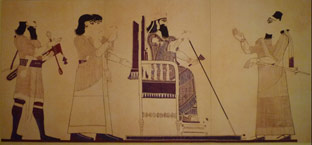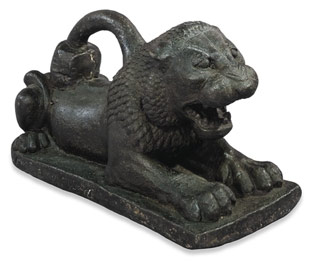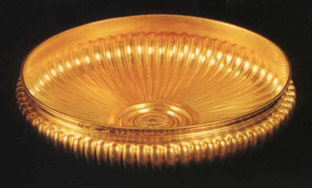Shalmaneser V, king of Assyria (726-722 BC)
The chosen heir of his father Tiglatpileser III (744-727 BC), Shalmaneser V was king of Assyria and king of Babylon. But his reign lasted less than five years and ended in a succession war which brought his brother, Sargon II (721-705 BC), to power.
Ululayu, the crown prince
As crown prince, the future Shalmaneser V was known as Ululayu. This fairly common name was certainly his birth name and means "born in Elul (i.e. the sixth month of the Assyrian calendar; c. August-September)". We do not know when Ululayu was promoted to the position of heir apparent to the Assyrian crown but five letters from the royal correspondence found at Kalhu in which he reports to his father, the king, attest to his activities during that period.
These letters have close parallels in the missives sent decades later by Sennacherib to his father and king, Sargon II: all of the crown princes' letters – but only these – include the phrase "Assyria is well, the temples are well, all fortresses of the king are well" and there is also an overlap in their remit as far as it emerges from the surviving correspondence. It is likely that this has less to do with their personal interests and more with the office of crown prince which they both held, which was the second highest position within the Assyrian state after the king, outranking even the Commander-in-Chief, the Chief Cupbearer and the Treasurer.
We see the crown prince Ululayu primarily deal with matters concerning the palace household in the king's absence: arranging for the palace to have sufficient supplies, for example of ice which was collected at the mountain peaks to the north and east of central Assyria and transported to Kalhu by river; co-ordinating the protection details for the queen's travels; and receiving ambassadorial delegations visiting the royal palace. Diplomatic relations seem to be one of his major concerns as we also see him monitor the reception of Assyrian state gifts abroad. The known letters show him dealing notably with Assyria's western vassal kingdoms: Carchemish, Commagene (Kummuhu), Gurgum, Que, Sam'al, Ashdod and Moab. He must have acquired a good knowledge of these regions during that time, an excellent preparation for the military campaigns which he conducted against some of these states as king of Assyria.

This scene from the painted wall decoration of the 8th century Assyrian palace of Hadatu (modern Arslan Tash) in Syria shows the seated king Tiglatpileser III receiving a report from the crown prince who can be identified by his distinctive headdress. The man depicted is therefore Ululayu, who eventually succeeded to the Assyrian throne as king Shalmaneser V. Reconstruction on display in the Louvre; photo by Karen Radner. View large image.
A short-lived king and his throne-snatching brother
After Tiglatpileser's natural death, Ululayu ascended to the throne without a challenge. Like his father, he ruled not only as king of Assyria but also as king of Babylon. Instead of his everyday name he adopted a glorious throne name, Shalmaneser, meaning "the god Salmanu is foremost". Such a name was only fit for a ruler of Assyria and invoked the memory of distinguished predecessors such as the 13th century king Shalmaneser I and Shalmaneser III (858-824 BC) – both well known for their conquests of regions to Assyria's west. The new king also adopted this political programme and continued the subjugation of the west initiated by his father.
Because of his short reign, very few official documents commissioned by Shalmaneser V survive: a brick inscription from Apqu (Tall Abu Mariya) shows that he undertook building work in this north Assyrian city but otherwise only a set of lion-shaped weights from Kalhu bears the official inscriptions of this king. Nevertheless, circumstantial evidence allows us to conclude that three new provinces were created in the west in Shalmaneser's reign: Samaria, the southern part of the kingdom of Israel, and Sam'alla and Que in the region of Adana in south-eastern Turkey.
However, in 722 BC, Sargon replaced his brother Shalmaneser as king of Assyria amidst murky but decidedly violent circumstances. Shalmaneser's fate is unknown but that the succession was awkward is plainly indicated by the fact that Sargon's voluminous body of royal inscriptions contains just one reference to his predecessor: in it, Sargon has his brother condemned as a godless tyrant who had robbed the city of Assur of its traditional privileges. One can safely assume that unless Shalmaneser managed to flee to one of Assyria's enemy states and found asylum there (for which there is no indication at all), he met his death in the struggle for the kingship of Assyria.

This bronze weight in the shape of a lion was found at Kalhu as part of a set of different sizes, ranging from 2 cm to 30 cm in length. Our example measures 28.5 cm and weighs 15 kg. This corresponds to "fifteen royal mina", as the Aramaic inscription engraved on the lion and indicating its weight has it. There is a connection between the weight's shape of a lion, the royal animal, and the fact that it was used to measure units of weight according to the royal standard, which is twice that of the the regular standard; the latter was usually measured using weights in the shape of ducks. Photo © British Museum, ME 91220.https://www.britishmuseum.org/collection/object/W_1848-1104-66 [https://www.britishmuseum.org/collection/object/W_1848-1104-66]View large image on the British Museum's website.
Queen Banitu
While her husband's last resting place is not known, the burial of Shalmaneser's wife and queen, Banitu, has been located in the Northwest Palace at Kalhu. However, a mystery remains. Some of her grave goods (a golden wine bowl and an electron cosmetics container) were discovered in 1988 in the tomb, and even the sarcophagus, of Tiglatpileser's queen Yaba (Tomb 2); they can be identified by their inscriptions: "Belonging to Banitu, queen of Shalmaneser, king of Assyria". However, there is a problem with matching the bodies in this grave with the number of known occupants: there are too few skeletons. According to their inscriptions, there are grave goods belonging to three queens: Yaba queen of Tiglatpileser, Banitu queen of Shalmaneser and Atalia queen of Sargon II, while the sarcophagus contains the remains of only two bodies. The one at the bottom of the coffin is surely that of Yaba and the one laid to rest on top of her is likely to be Atalia – but where is Banitu?
 [http://www.aina.org/aol/nimrud/pot4.jpg]
[http://www.aina.org/aol/nimrud/pot4.jpg]This golden bowl from among the grave goods discovered in Tomb 2 at Kalhu is inscribed with a cuneiform inscription giving the name and title of Banitu, queen of Shalmaneser V. Its form identifies it as a wine cup; wine was consumed at the Assyrian court during royal banquets following a precise formal procedure involving elaborate serving protocols and precious luxury vessels whose materials indicated the social status of its consumer. Only the members of the royal family were entitled to golden tableware. Iraq Museum, IM 105698. Photo taken from Aina.org [http://www.aina.org/aol/nimrud/pot4.jpg].
It is of course possible that Sargon's queen Atalia inherited some possessions from her predecessor Banitu and was buried with them. But there may be another, more intriguing, solution to the puzzle. The names of both queen Yaba (West Semitic) and queen Banitu (Akkadian) mean "the beautiful one", and they may indeed have been the same person, a hypothesis strengthened by two facts: one, Naqia, the famous mother of king Esarhaddon, was also known under the Akkadian version of her West Semitic name, Zakutu; and two, Shalmaneser III is certain to have taken the last wife of his father Assurnasirpal II (883-859 BC) in marriage in the course of his ascension to the throne. If the assumption that Yaba, queen of Tiglatpileser, and Banitu, queen of Shalmaneser, are one and the same person is correct then Shalmaneser V, too, would have married his father's widow – who would certainly not have been his own mother but another, perhaps younger, wife of the king (the remains have been identified as belonging to a woman of about 30-35 years of age) – in an attempt to further secure the succession: an old and tested strategy but one that ultimately proved to have been in vain in this particular case.
Further reading
- Baker, 'Salmanassar V.', 2008.
- Dalley, 'The identity of the princesses in Tomb II and a new analysis of events in 701 BC', 2008.
- Fales, 'Assyro-Aramaica: the Assyrian lion-weights', 1995.
- Müller-Karpe, Kunter & Schultz, 'Results of the paleopathological investigations on the royal skeletons from Nimrud', 2008.
- Radner, 'Salmanassar V. in den Nimrud Letters', 2003/04.
- Tadmor and Yamada, 'The Royal Inscriptions of Tiglath-Pileser III (744-727 BC) and Shalmaneser V ( 726-722 BC), Kings of Assyria', 2011.
- Vera Chamaza, 'Sargon II's ascent to the throne: the political situation', 1992.
Content last modified: 11 Nov 2021.
Karen Radner
Karen Radner, 'Shalmaneser V, king of Assyria (726-722 BC)', Assyrian Empire Builders, University College London, 2021 [http://oracc.museum.upenn.edu/saao/aebp/essentials/kings/shalmaneserv/]